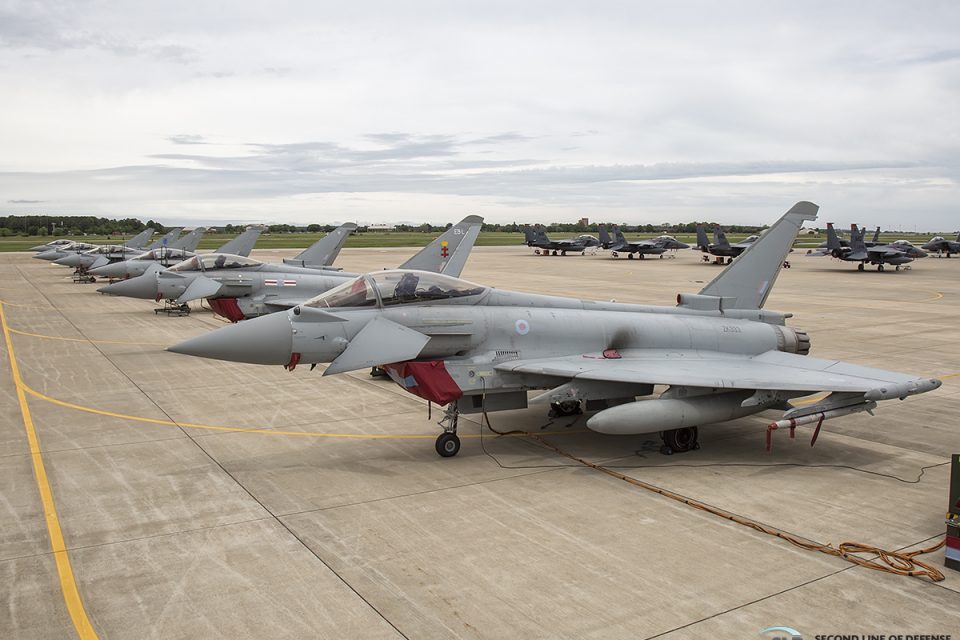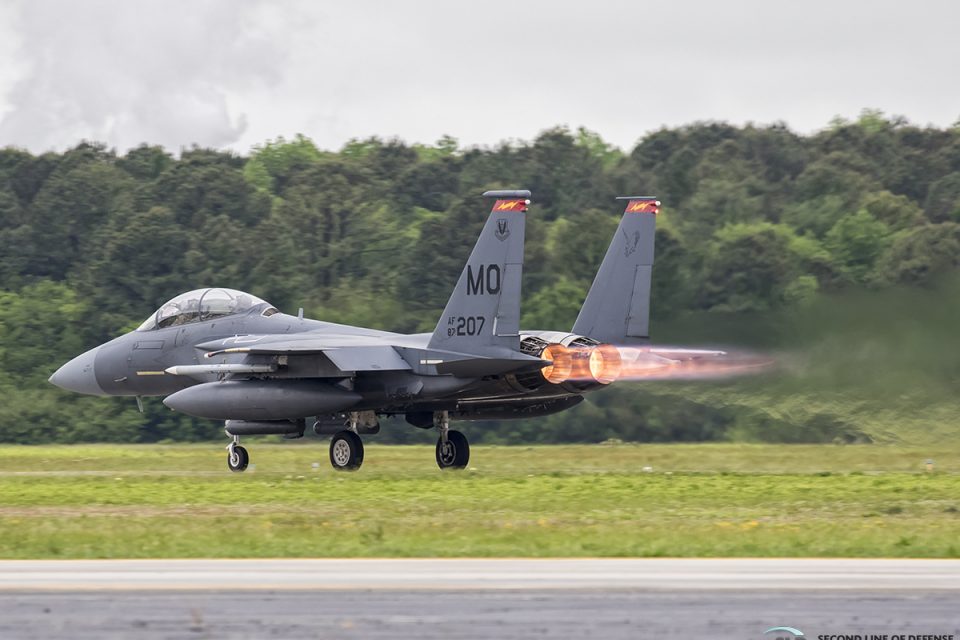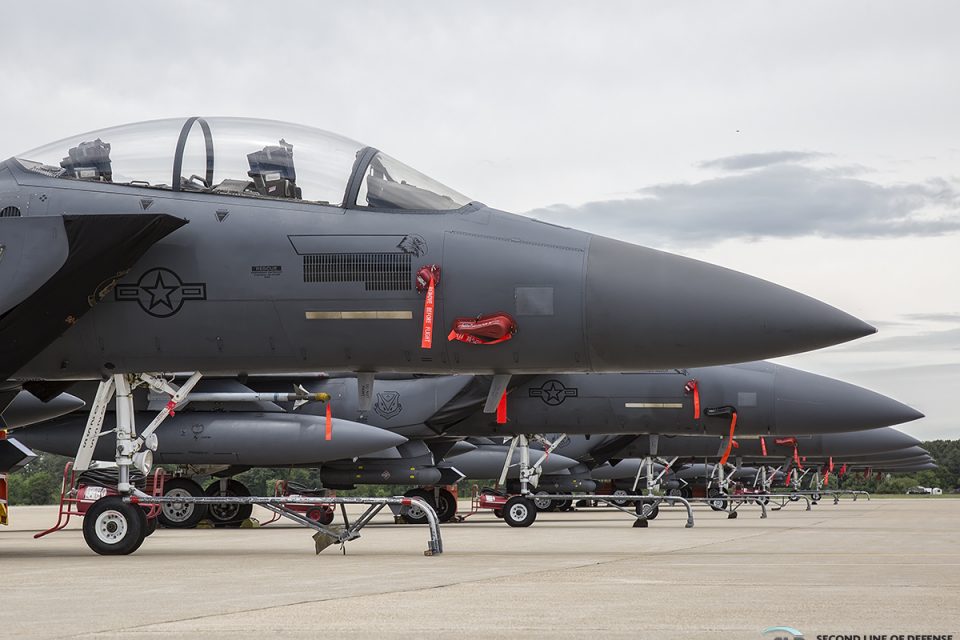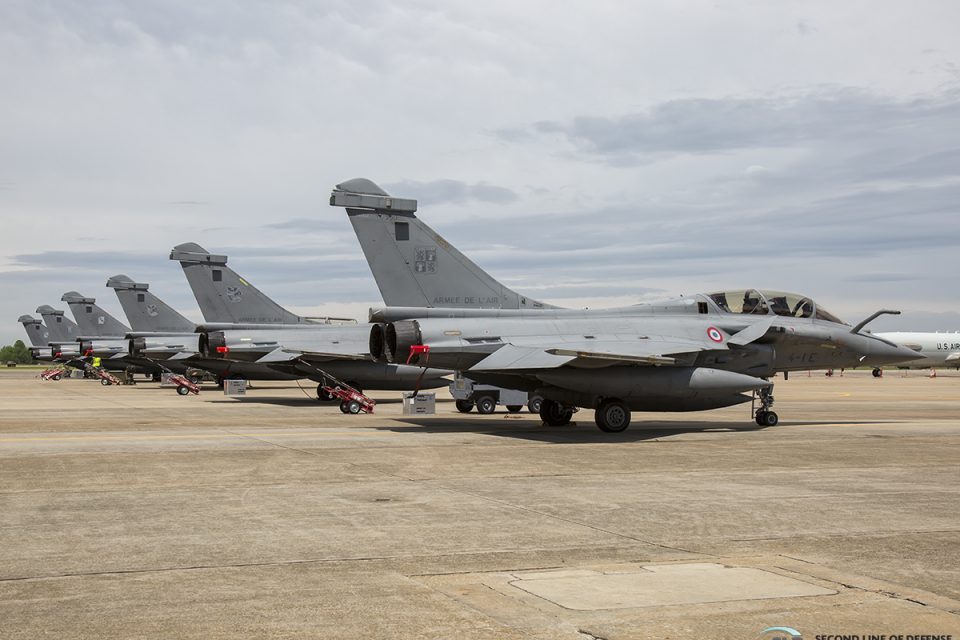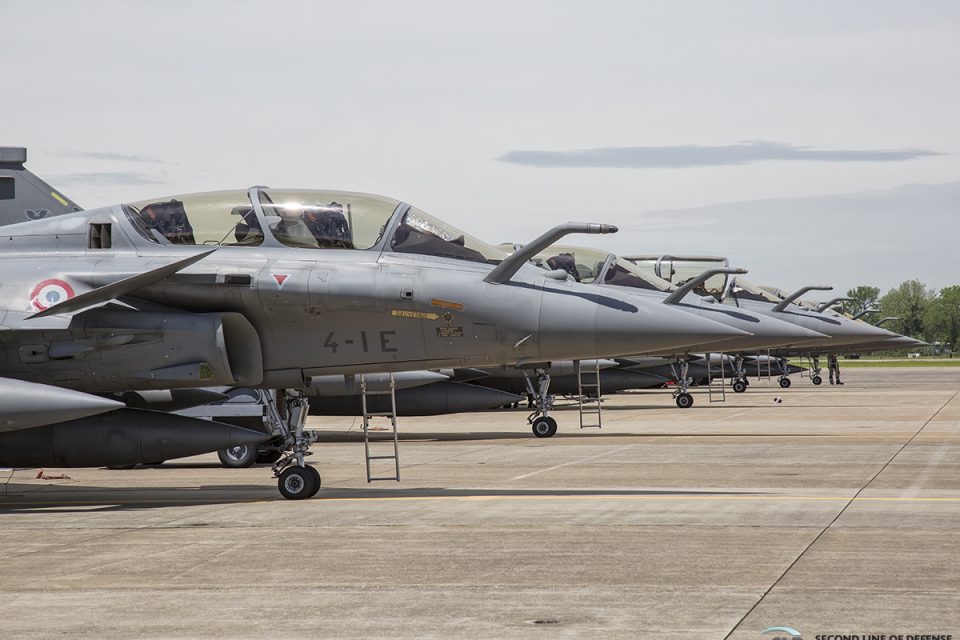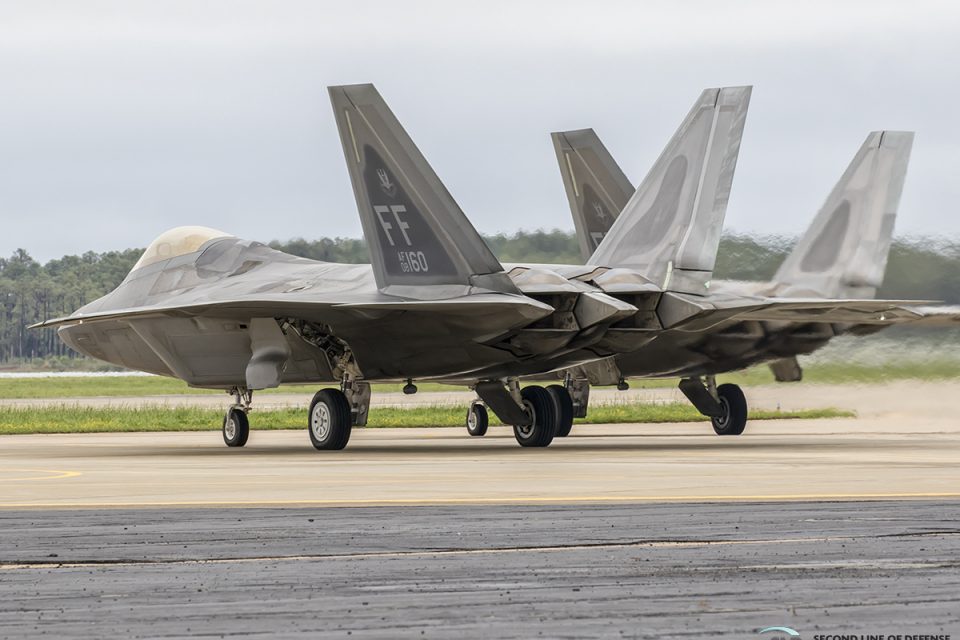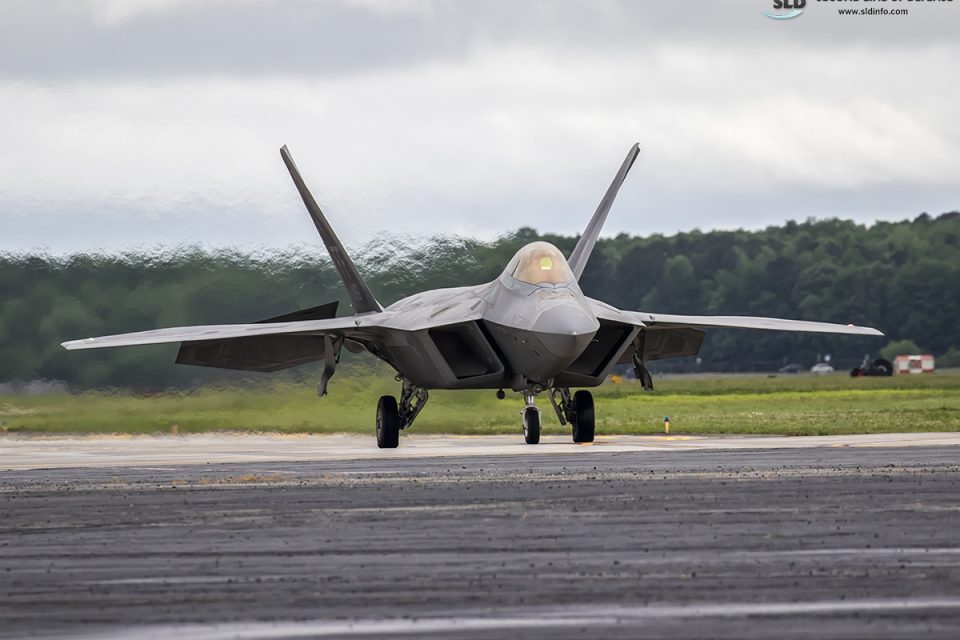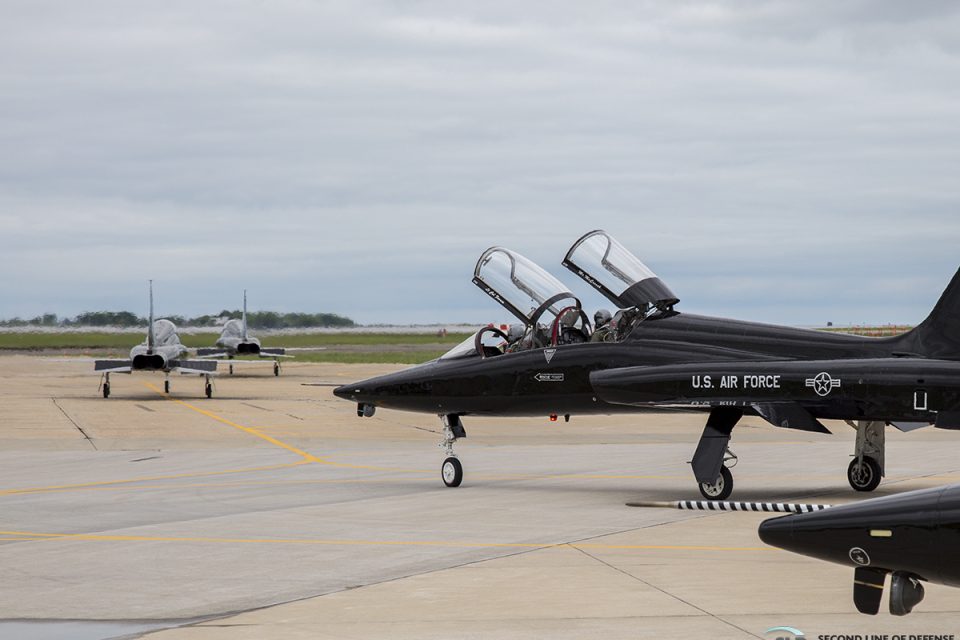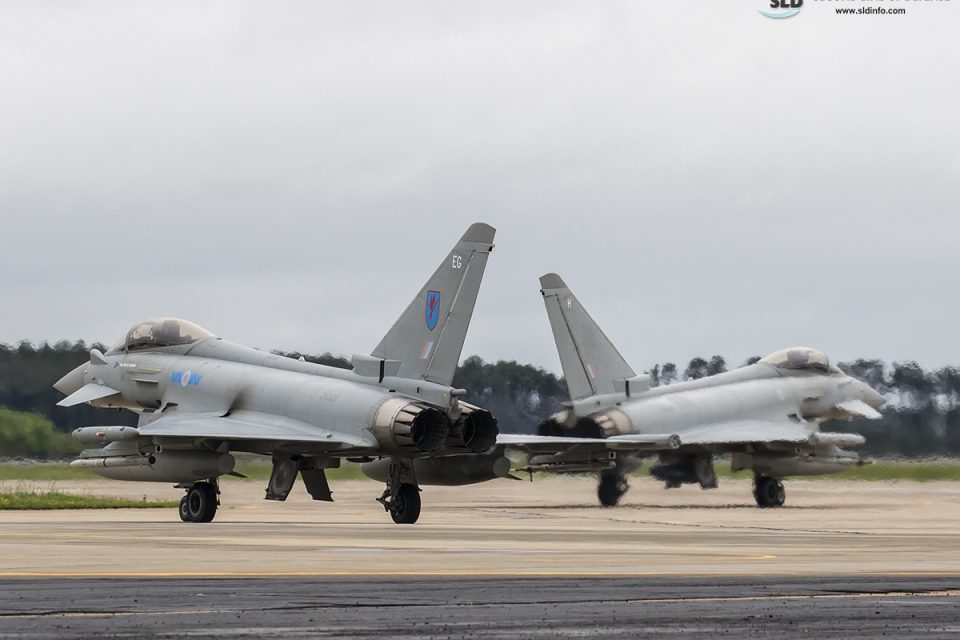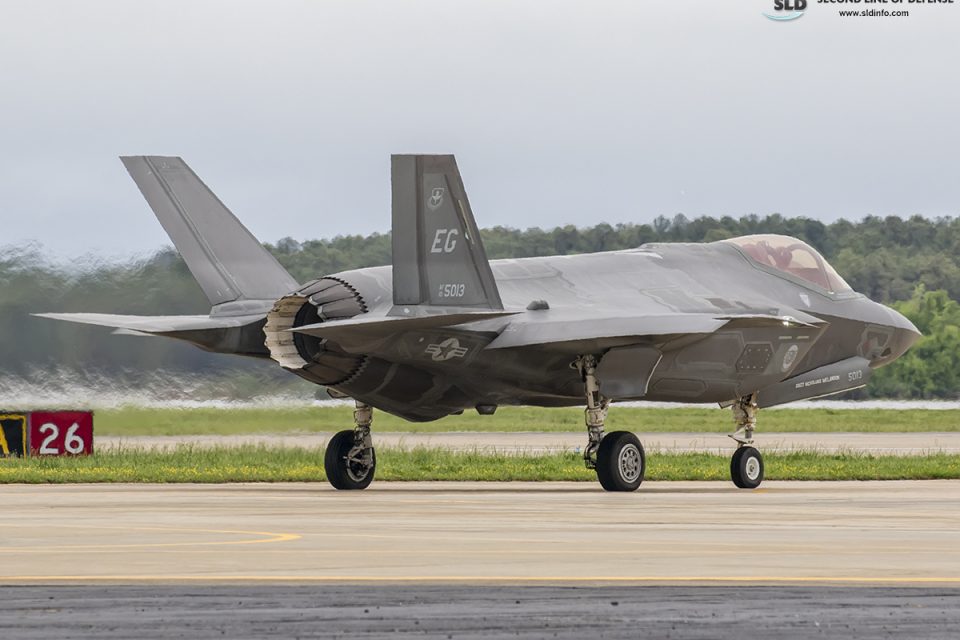2017-05-01 by Todd Miller
Atlantic Trident ’17 brought together in type and capability the most advanced 21st century allied combat fighter force being flown today.
The exercise held April 12 – 28 at Joint Base Langley-Eustice (JBLE) included a “Blue Air” force of USAF F-22 Raptors of the 1st Fighter Wing (FW) JBLE and F-35 Lightning IIs from Eglin AFB, Typhoons of the Royal Air Force (RAF) and Rafales of the French Air Force/Armée de l’Air (FAF).
The adversaries or “Red Air” included USAF F-15E Strike Eagles of the 391st FS “Bold Tigers” Mountain Home AFB, ID and T-38A Talons of the 71st Fighter Training Squadron (FTS) “Ironmen” based at JBLE.
Additional assets included the E-3A Sentry from Tinker AFB, OK and a variety of tankers, including a FAF KC-135 and KC-10 of the 305th Air Mobility Wing (AMW) out of Joint Base McGuire-Dix-Lakehurst, NJ.
Aside from the primary training objectives the exercise also provided the opportunity to commemorate 100 years of aerial combat cooperation between the French and US stemming back to WW I.
From the outside looking in the lethal capabilities of Blue Air appeared to be overwhelming, with Red Air offering little challenge.
However, one must consider that the 71st FTS “Ironmen” fly daily as adversaries against the Raptor and possess pilots with Raptor experience.
These factors (along with the sheer numbers of Red Air fielded and their ability to “regenerate” on range) provide Red Air with the best likelihood to exploit any vulnerabilities or errors with Blue Air’s tactics – regardless their impressive platforms.
Towards the end of the exercise the Second Line of Defense sat down with Colonel Pete “Coach” Fesler, 1 FW Commander to discuss the exercise and the evolution of air combat in the context of 5th Gen aircraft.
On a broad level the USAF anticipates any future conflict to be fought with a coalition of allies.
Exercises such as Red Flag (Nellis AFB) and Red Flag Alaska, Pitch Black (hosted by Australia), Frisian Flag (Netherlands) and many others integrate Tactics, Techniques and Procedures (TTPs) among participants.
When the next conflict arises the USAF and relevant coalition partners will be familiar with TTPs, and integrate day one into an effective aerial fighting force.
Fesler noted that Atlantic Trident ’17 took integration beyond historical practice.
“On a tactical level integration historically involved a serial employment of aircraft (such as a Combat Air Patrol of RAF Typhoons) or geographical deconfliction of aircraft (such as FAF assets attacking ground targets in a designated area).”
However, as Fesler explained starting with “Red Flag 17-1 integration has gone deeper, involving a variety of platforms in the same airspace at the same time.
Integration between platforms also considered the various loiter time and weapons load/type for a given platform over a given vulnerability period (vul – the period of time when an aircraft is vulnerable to harm).”
While not being specific, it is not difficult to envision a mixed strike package of Rafales and F-35s, a combat air patrol (CAP) of Typhoons and Raptors (or mix and match on any given mission set).
This level of integration leads to big challenges for an adversary who may easily be fixated on attacking a detected Gen 4.5 aircraft, while getting blindsided by a 5th Gen platform or a be distracted by a 5th Gen threat “sensed” in the area and get bounced by a very capable Typhoon or Rafale.
Hesitation in such air to air combat will most likely be punished with an ending in a ball of flames.
This possibility will certainly lead to an increased wariness on the part of an adversary.
Given the high SA of the 5th Gen aircraft with their much shorter “observe, orient, decide, act” (OODA) loop the integrated force places an adversary at a distinct disadvantage.
A lack of decisiveness in modern air to air combat will most certainly be punished with an ending in a ball of flames.
The ability to intake, consolidate and distribute key elements of real time combat information by a fifth generation enabled combat force drives a much higher level of integration.
Fesler noted that “multiple people/assets may be involved with the finding, identifying and targeting portion of an air to air encounter.
The pilot may take care of the final step and fire the missile that kills the target, but wouldn’t have found their way to that merge unless the assets got them there.”
This discussion has implications for the debates on the F-35s kill ratios.
As Fesler expresses, “without the context, the kill ratio means nothing.
For example, what were we asking the F-35 to do at the time, was it predominantly in an air to ground role and only picking up the occasional leaker?
Well then that may lead you to the number of 15.
But if the F-35 was in a Defensive Counter Air (DCA) role with solely an air to air responsibility -one could expect a fundamentally different number.”
Atlantic Trident ’17 provided an opportunity to demonstrate how the advancement of aircraft, tactics and integration is driving change in the function of the fighter force.
For many years, the F-22 Raptor has utilized its superior sensors and SA to take the role of “quarterback” during a vul.
Given the integration of the F-35 and with weapons/loiter capabilities of the Typhoon and Rafale, the notion of a “single quarterback” is changing.
Frankly, per Fesler, the quarterback notion is starting to become “almost a misnomer now in that we have multiple quarterbacks and its less about one individual directing everything and more about multiple nodes of information being able to provide the key pieces of information at the right time to influence the fight.”
It is a foreboding thought for an adversary who now faces a team, where every position has the intelligence/capability of a great quarterback, even while performing their specific role at the highest level.
Performing at a high level is one thing, altering the playing field is another.
The 5th Gen aircraft has done that very thing, altering the classic air to air engagement in a fundamental way.
Fesler noted,” the classic approach of shooting ones missiles and turning before the adversary can get a shot is predicated on the fact that the adversary sees you.
“In the 4th gen world that is the case.
“Ideally the pilot would like to be able to shoot, let their missile do the work and get away before the adversary can get a missile off.
“In the F-22 and F-35 world, the adversary doesn’t necessarily know where you are coming from.
“The 5th Gen pilot might shoot a missile and monitor to make sure it is effective.
“If the missile misses for any number of reasons, they are in good position for a follow-up shot.
“That is one of the fundamental difference between 4th Gen fighters and 5th Gen fighters.
“In general, in the 5th Gen world the adversary doesn’t really know where you are coming from.
“They may have a general idea but not a lot of specifics.
“For 5th Gen pilots it’s a good place to be, to be able to roam around the battlefield faster than the speed of sound in an airplane that is largely undetectable all while your airplane is building a 3 dimensional picture of everything within a couple hundred miles of you.
Aside from the exceptional technical aspects that fascinate and draw attention, Felser ultimately notes that his takeaways from Atlantic Trident ‘17 fall back to the human aspect; “fighter pilots are fighter pilots regardless of what their uniforms look like. Aircraft maintainers are aircraft maintainers regardless of what their uniforms look like.
“There are some universal experiences, beliefs and cultures that transcend the national boundaries in this and that’s one of the things I have enjoyed out of both Tri-lateral exercises (2015 & AT ‘17) that we’ve had.
“The man in the machine still makes a difference.
“You can have the most lethal fighter in the world but if you make a mistake a far inferior aircraft can shoot you out of the sky.
“Training still matters.
“If that were not the case, we’d buy the machines, park them and never fly them and when war kicked off jump in them and go and fly, but that in fact is not the case and you can lose a war with the best equipment if you don’t know how to use it right, if your tactics aren’t sound, if your skills aren’t automatic, you can still lose.”
Atlantic Trident ‘17 reveals the way forward; advanced integration, people making a difference, and high level training.
This rationale drives the US Air Force working with core allies to try to ensure that it is ready with the highest capability for the next conflict on day 1.
In short, 5th Gen brought an evolving approach to integration and evolving A2A tactics to the forefront at Atlantic Trident ‘17.
The Second line of Defense expresses gratitude to Jeffrey Hood 633 ABW PA and the entire 633 ABW Public Affairs Team who were instrumental and exceptional with their support; Col. Pete “Coach” Fesler, 1 Fighter Wing Commanding Officer, and the entire 1 FW; the entire team at Joint Base Langley-Eustis, professional and gracious throughout the visit. You set the bar, our service people are the finest.
Editor’s Note: In discussions with USAF, RAF, and RAAF pilots who participated in Red Flag 17-1, the shift in how integration is done and the reshaping of combat effects was highlighted.
With the F-35 in RF17-1, the entire combat force was reconfigured to get maximum advantage from the performance of the other air combat assets.
This reshuffling was driven by the forward operating SA of the F-35 and its ability to make decisions on the fly and to drive appropriate information to informed combat assets to deliver ordinance on target.
With regard to the RAAF and its participation in Red Flag 2017-1 and the role of Wedgetail, Group Captain Bellingham had this to say about the evolving approach to fifth generation enabled air combat:
Question: I think Red Flag 17-1 is a good example of how we collectively are shaping a way ahead.
In effect, we are seeing the training of a network of operators who can shape high intensity air operations under the impact of fifth generation warfighting concepts.
The technology is crucial; the platforms are important; but it is the training towards where we need to go that is crucial, rather than simply training to the past.
Is that not where your experience with Wedgetail and working with allies comes in?
Group Captain Bellingham: That is a good way to set up the discussion.
I think the strength of everything we’re doing at the moment only comes from a strong cooperation with our allies. Obviously, we’re a tiny force, and our relevance and real strength becomes fully apparent when we tie our capabilities with those of our allies.
At Red Flag 17-1, we saw the US, the UK and Australia blending advanced assets together to make the entire force more lethal and survivable in the high end threat environment.
And in a discussion with RAF pilots participating in Red Flag 17-1, the key impact which the F-35 has on the combat force.
“As we introduce the F-35, the pilots have to adjust to the fact that their machines will see and convey data that they themselves are not looking at.
“And different airplanes will have different levels of SA in the battlespace.
“How to adjust the operation of the force to meet this challenge?”
And there are legacy and then legacy aircraft when it comes to the impact of the F-35.
“If you optimize the relationship between fourth and fifth-gen surely you’d have your fourth-gen as out of harm’s way as you could as they are not low observable amongst those things.
“Therefore, you’d want to have onboard the 4th gen aircraft longest-range weapon you could possibly manage and I don’t think a Hornet of any variety is the right platform for that.
“And actually Typhoon, whether it’s by accident or by design, does give you that especially with Meteor.”
And the RAF is moving ahead with F-35 and Typhoon integration on the connectivity level as well.
In the Babel Fish III trial in February 2017, enhanced connectivity was demonstrated.
“During the trial, the Northrop Grumman Airborne Gateway connected the fifth-generation F-35B, which communicates using the stealthy Multifunction Advanced Data Link, and the fourth-generation Typhoon, by translating MADL messages to Link 16 format. Link 16 is the U.S. and NATO military tactical data link used by some military aircraft, ships and ground forces to communicate and exchange tactical data.
The F-35 and the Typhoon can communicate directly via Link 16 but previously could not communicate or share certain fifth-generation information.”
Andrew Tyler, chief executive, Northrop Grumman Europe said:
“Being able to network sensor data between fifth-generation and fourth-generation fast-jets and other battlespace assets in a stealthy manner is critically important to enabling the full capability offered by fifth-generation aircraft.
We are pleased to have played our part in this successful trial, the output of which will help the MOD to broaden its understanding of the effect that can be generated by its fifth-generation combat-air fleet.”
Air Commodore Linc Taylor Senior Responsible Owner for the UK’s F-35 Programme said:
“I have been enormously impressed both by the collegiate effort to make the Babel Fish III trial happen so successfully, and the specific outcomes of the trial.
This marks another great step forward in interoperability between our fourth- and fifth- generation aircraft, putting the RAF at the forefront of this work. We plan to continue to understand and develop where the most capability and interoperability benefit lies through a series of future trials along similar lines.”
According to the company:
“Bridging this fifth-to-fourth generation platform interoperability gap was made possible by the inclusion of a Northrop Grumman Freedom 550™ software-defined radio in the Airborne Gateway.
The Freedom 550™ is derived from the integrated communications, navigation and identification avionics suite the company developed and manufactures for the F-35; it was validated under the Jetpack Joint Capability Technology Demonstration programme, an effort sponsored by the Office of the Secretary of Defense and U.S. Air Force that concluded in 2014.
Northrop Grumman’s Airborne Gateway translates and relays information from various sources across diverse platforms and domains to enhance interoperability, situational awareness, communications and coordination for warfighters in the air, on the ground and at sea. The system is derived from the combat-proven airborne communications node that Northrop Grumman provides to the U.S. Air Force.”
F-35 aircraft have also successfully passed target data off to Typhoon jets who then successfully engaged the target during Exercise Red Flag.
The F-35 is designed to share what it sees with legacy aircraft. The US Air Force state that the lethality of the aircraft comes from ‘a combination of stealth, electronic attack, information sharing, and other features make the platform an invaluable part of a modern air-strike package.’
Col. George Watkins, 34th Fighter Squadron commander said:
“Our strength with the F-35 has been finding the threats.
We use our onboard system to geo-locate and get a picture of the target, day or night, through the weather. We pass that threat information to others while using our stealth capability. We can get a lot closer to the advanced threat than anyone else can get.
That allows us to target them out and take out critical assets.”
Lt. Col. Dave DeAngelis, F-35 pilot and commander of the 419th Operations Group said:
“During one scenario, the Airmen were given a general location by advanced intelligence, surveillance and reconnaissance aircraft. The F-35s were tasked with finding a convoy carrying a high-value target.
The F-35s advanced targeting capabilities were able to pinpoint the convoy’s location. They then communicated that to British Typhoon fighters who took out the target.
The thing that’s great about having Link 16 and MADL onboard and the sensor fusion is the amount of situational awareness the pilot has. I’m able to directly communicate with specific formations and I can see the whole war, and where all the other players are, from a God’s-eye view. That makes me a lot more effective because I know who to talk with and at what times, over the secure voice.”
The F-35 uses the Link 16 secure architecture to communicate with fourth-generation aircraft in the Red Flag fight and combined with the Multifunction Advanced Data Link, which allows pilots to see the battlespace and share that data with other F-35 pilots.
Using the F-35 as a broad area sensor can also significantly increase a warships ability to detect, track and engage a target.
An unmodified US Marine Corps F-35B from the Marine Operational Test and Evaluation Squadron, based in Edwards Air Force Base, acted as an elevated sensor to detect an over-the-horizon threat.
The aircraft then sent data through its Multi-Function Advanced Data Link to a ground station connected to USS Desert Ship, a land-based launch facility designed to simulate a ship at sea.
Using the latest Aegis Weapon System Baseline 9.C1 and a Standard Missile 6, the system successfully detected and engaged the target.
The exercise was the first live fire missile event that successfully demonstrated the integration of the F-35 to support Naval Integrated Fire Control-Counter Air and represent a very promising exploration into the interoperability of the F-35B with other naval assets.
The F-35 will drastically increase the situational awareness of the forces with which it will deploy and for the UK, where deployed numbers may be a concern, it represents a fantastic way to enhance combat capability in any coalition or national effort.
RAF demonstrate Multifunction Advanced Data Link interoperability between F-35B and Typhoon



